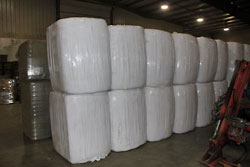
Timothy hay grows extremely well in Western Canada’s growing conditions. The clean air, rich soil and cooperative climate all contribute to the production of some of the most palatable hay in the world. Since this Timothy hay is grown at higher altitudes, with long warm summer days and cool nights during the growing season, it matures with an increased sugar content and makes excellent forage for livestock.
Canadian Timothy hay and other forages are in demand in Japan and other countries along the Pacific Rim. It is used as forage for beef and dairy cattle, as well as in the horse industry in certain parts of Asia. It’s a nutritious source of fibre, encourages growth and is beneficial to livestock producers who do not have the land or the means to grow it locally. As a result, the export market for Canadian hay has expanded rapidly.
Canadian hay growers see hay processors and exporters like Barr-Ag as their consumer. They will sell their crops to a local exporter, where the Timothy hay is compressed and processed for shipment. The true customer is the export market. Canadian hay growers who want access to the export market should contact a hay processor to learn about market demands, specific standards for raw material and the preference of the international customer. .
Product quality is incredibly important when trying to sell your crops to a hay processor and exporter. Shipping products like Timothy hay such large distances is very expensive. In order to ensure the needs and expectations of the international customer are met, a hay processor must hold a high standard for the hay it chooses to purchase, process and export.
In regards to Timothy hay, the end-user is looking for long, course stems with long heads. The stems should be green, leafy and have a minimum of brown leaves. It should be free of mold, weeds, or other plant species and contaminants. It must have a low moisture content to ensure mold and moisture damage doesn’t occur during transport or storage.
Processing the crop into compressed bales can reduce shipping costs. Timothy hay can be compressed or even double compressed to better fit into transportation containers. They are usually transported by truck to a container yard, then picked up by rail and moved to a Canadian port. If the hay is going to Asia it will be moved to a port in Vancouver, shipments going to Europe travel to Montreal, and shipments going to the United States are transported via Chicago and/or Fort Lauderdale. From these ports they’re loaded on ocean container ships and sent to overseas markets.


In order to ship Timothy hay to international markets the hay exporter must obtain a Phytosanitary Certificate. This is the official document issued by the plant protection organization of the exporting country to the plant protection organization of the importing country. It makes sure the product has been inspected, free of quarantine pests, and cleared according to specific regulations of the country receiving the shipment.
Some markets do not hold as strict standards as Japan. If the baled Timothy hay does not meet Japanese requirements it can be sold to residual markets such as Korea or Taiwan. A hay processor can also market single-compressed hay in the USA, Europe, the Caribbean and Middle East as they each have different requirements and may accept a variety of Canadian hay products.
For more information on selling your Canadian grown Timothy hay, contact Barr-Ag. If you’re interested in importing Canadian forage, click on the image and fill our the request form.




